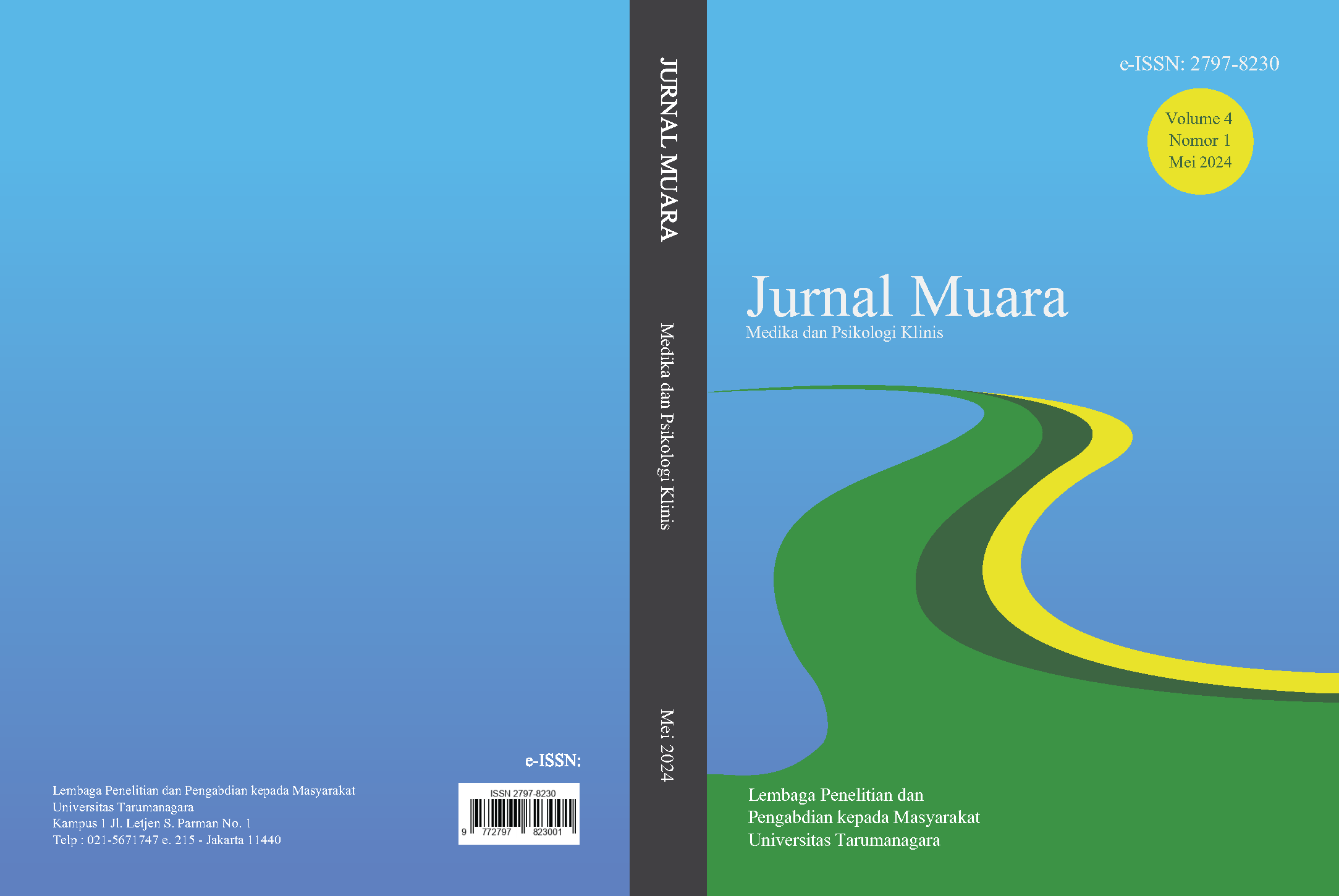ASSESSING THE PREDICTIVE ROLE OF LIPID PROFILE AND DIABETES MELLITUS PANEL ON FECAL INCONTINENCE SEVERITY
Main Article Content
Abstract
Latar Belakang: Inkontinensia fekal (FI) adalah masalah umum di kalangan lansia yang secara signifikan mempengaruhi kualitas hidup mereka. Ini terkait dengan tantangan fisik dan psikologis. Disregulasi kadar glukosa dan lipid telah terlibat dalam FI, dengan obesitas dan hiperlipidemia berkontribusi pada peradangan sistemik dan kerusakan jaringan. Memahami faktor metabolik yang mempengaruhi FI dapat membantu dalam mengembangkan intervensi yang ditargetkan. Tujuan: Studi ini mengeksplorasi hubungan antara profil lipid, indikator diabetes mellitus, dan tingkat keparahan FI pada individu lanjut usia. Metode: Studi analitik cross-sectional dilakukan dengan 93 orang lanjut usia dari Panti Jompo Bina Bhakti. Indeks Keparahan Inkontinensia Fekal (FISI) digunakan untuk menilai keparahan FI. Profil lipid dan panel diabetes mellitus diperoleh melalui tes darah vena. Analisis statistik termasuk Spearman's Rho dan analisis regresi berganda. Hasil: Studi ini menemukan korelasi negatif yang signifikan antara kadar LDL dan keparahan FI, menunjukkan peran protektif LDL dalam menjaga integritas jaringan anorektal. Demikian pula, kadar HbA1c berhubungan terbalik dengan keparahan FI, menunjukkan bahwa kontrol glikemik yang lebih baik terkait dengan gejala FI yang berkurang. Parameter lipid dan indikator glikemik lainnya tidak menunjukkan dampak signifikan pada keparahan FI. Kesimpulan: Temuan ini menunjukkan bahwa manajemen lipid dan kontrol glikemik sangat penting dalam mengelola FI pada lansia. LDL dan HbA1c muncul sebagai penanda potensial untuk menilai risiko dan keparahan FI. Untuk meningkatkan hasil bagi pasien lanjut usia dengan FI, pendekatan multifaktorial, termasuk intervensi diet dan farmakologis, harus diprioritaskan.
Article Details

This work is licensed under a Creative Commons Attribution-NonCommercial-ShareAlike 4.0 International License.
This work is licensed under a Jurnal Muara Ilmu Ekonomi dan Bisnis Creative Commons Attribution-ShareAlike 4.0 International License.References
Akhtar, A.J., Padda, M., 2005. Fecal incontinence in older patients. J Am Med Dir Assoc 6, 54–60. https://doi.org/10.1016/j.jamda.2004.12.012
Andersen, C.J., 2022. Lipid Metabolism in Inflammation and Immune Function. Nutrients 14, 1414. https://doi.org/10.3390/nu14071414
Bharucha, A.E., Dunivan, G., Goode, P.S., Lukacz, E.S., Markland, A.D., Matthews, C.A., Mott, L., Rogers, R.G., Zinsmeister, A.R., Whitehead, W.E., Rao, S.S.C., Hamilton, F.A., 2015. Epidemiology, Pathophysiology, and Classification of Fecal Incontinence: State of the Science Summary for the National Institute of Diabetes and Digestive and Kidney Diseases (NIDDK) Workshop. American Journal of Gastroenterology 110, 127–136. https://doi.org/10.1038/ajg.2014.396
Boland, B.S., Edelman, S. V., Wolosin, J.D., 2013. Gastrointestinal Complications of Diabetes. Endocrinol Metab Clin North Am 42, 809–832. https://doi.org/10.1016/j.ecl.2013.07.006
Jamieson, H.A., Schluter, P.J., Pyun, J., Arnold, T., Scrase, R., Nisbet-Abey, R., Mor, V., Deely, J.M., Gray, L., 2017. Fecal Incontinence Is Associated With Mortality Among Older Adults With Complex Needs: An Observational Cohort Study. American Journal of Gastroenterology 112, 1431–1437. https://doi.org/10.1038/ajg.2017.200
Knowles, C.H., Dinning, P., Scott, S.M., Swash, M., de Wachter, S., 2022. New concepts in the pathophysiology of fecal incontinence. Ann Laparosc Endosc Surg 7, 15–15. https://doi.org/10.21037/ales-2022-02
Li, Z., Chen, X., Huang, J., Cheng, F., Wu, Z., Yuan, L., Li, X., Shen, W., 2024. Association between dietary inflammatory index and fecal incontinence in American adults: a cross-sectional study from NHANES 2005–2010. Front Nutr 11. https://doi.org/10.3389/fnut.2024.1364835
Lumban Gaol, L., Purba, A., Diposarosa, R., Pratiwi, Y., 2024. Role of Hypoxic Secretome from Mesenchymal Stem Cells in Enhancing Tissue Repair: Regulatory Effects on HIF-1α, VEGF, and Fibroblast in a Sphincterotomy Rat Model. J Inflamm Res Volume 17, 7463–7484. https://doi.org/10.2147/JIR.S480061
Mack, I., Hahn, H., Gödel, C., Enck, P., Bharucha, A.E., 2024. Global Prevalence of Fecal Incontinence in Community-Dwelling Adults: A Systematic Review and Meta-analysis. Clinical Gastroenterology and Hepatology 22, 712-731.e8. https://doi.org/10.1016/j.cgh.2023.09.004
Malekmohammad, K., Bezsonov, E.E., Rafieian-Kopaei, M., 2021. Role of Lipid Accumulation and Inflammation in Atherosclerosis: Focus on Molecular and Cellular Mechanisms. Front Cardiovasc Med 8. https://doi.org/10.3389/fcvm.2021.707529
Meldgaard, T., Keller, J., Olesen, A.E., Olesen, S.S., Krogh, K., Borre, M., Farmer, A., Brock, B., Brock, C., Drewes, A.M., 2019. Pathophysiology and management of diabetic gastroenteropathy. Therap Adv Gastroenterol 12. https://doi.org/10.1177/1756284819852047
Musa, M. K., Saga, S., Blekken, L. E., Harris, R., Goodman, C., & Norton, C. (2019). The Prevalence, Incidence, and Correlates of Fecal Incontinence Among Older People Residing in Care Homes: A Systematic Review. Journal of the American Medical Directors Association, 20(8), 956-962.e8. https://doi.org/10.1016/j.jamda.2019.03.033
Pedreanez, A., Robalino, J., Tene, D., Salazar, P., 2024. Advanced glycation end products of dietary origin and their association with inflammation in diabetes – A minireview. Endocr Regul 58, 57–67. https://doi.org/10.2478/enr-2024-0007
Potere, N., Del Buono, M.G., Mauro, A.G., Abbate, A., Toldo, S., 2019. Low Density Lipoprotein Receptor-Related Protein-1 in Cardiac Inflammation and Infarct Healing. Front Cardiovasc Med 6. https://doi.org/10.3389/fcvm.2019.00051
Putnam, K., Shoemaker, R., Yiannikouris, F., Cassis, L.A., 2012. The renin-angiotensin system: a target of and contributor to dyslipidemias, altered glucose homeostasis, and hypertension of the metabolic syndrome. American Journal of Physiology-Heart and Circulatory Physiology 302, H1219–H1230. https://doi.org/10.1152/ajpheart.00796.2011
Saldana Ruiz, N., Kaiser, A.M., 2017. Fecal incontinence - Challenges and solutions. World J Gastroenterol 23, 11. https://doi.org/10.3748/wjg.v23.i1.11
Song, B., Bie, Y., Feng, H., Xie, B., Liu, M., Zhao, F., 2022. Inflammatory factors driving atherosclerotic plaque progression new insights. J Transl Int Med 10, 36–47. https://doi.org/10.2478/jtim-2022-0012
Stevens, T.K., Soffer, E.E., Palmer, R.M., 2003. Fecal incontinence in elderly patients: common, treatable, yet often undiagnosed. Cleve Clin J Med 70, 441–448. https://doi.org/10.3949/ccjm.70.5.441
Uranga-Ocio, J.A., Bastús-Díez, S., Delkáder-Palacios, D., García-Cristóbal, N., Leal-García, M.Á., Abalo, R., 2015. Enteric neuropathy associated to diabetes mellitus.
WATANABE, M., TSUNODA, A., KAMIYAMA, G., HIRANO, T., KUSANO, M., 2003. Pathophysiology in diabetic patients with fecal incontinence. The Showa University Journal of Medical Sciences 15, 21–26.
Yu, Z., Guo, M., Bai, X., Ruan, G., Sun, Y., Han, W., Yang, H., 2024. Exploring the association between cardiovascular health and bowel health. Sci Rep 14, 11819. https://doi.org/10.1038/s41598-024-62715-7
Zhu, F., Chen, M., Xiao, Y., Huang, X., Chen, L., Hong, L., 2024. Synergistic interaction between hyperlipidemia and obesity as a risk factor for stress urinary incontinence in Americans. Sci Rep 14, 7312. https://doi.org/10.1038/s41598-024-56744-5



